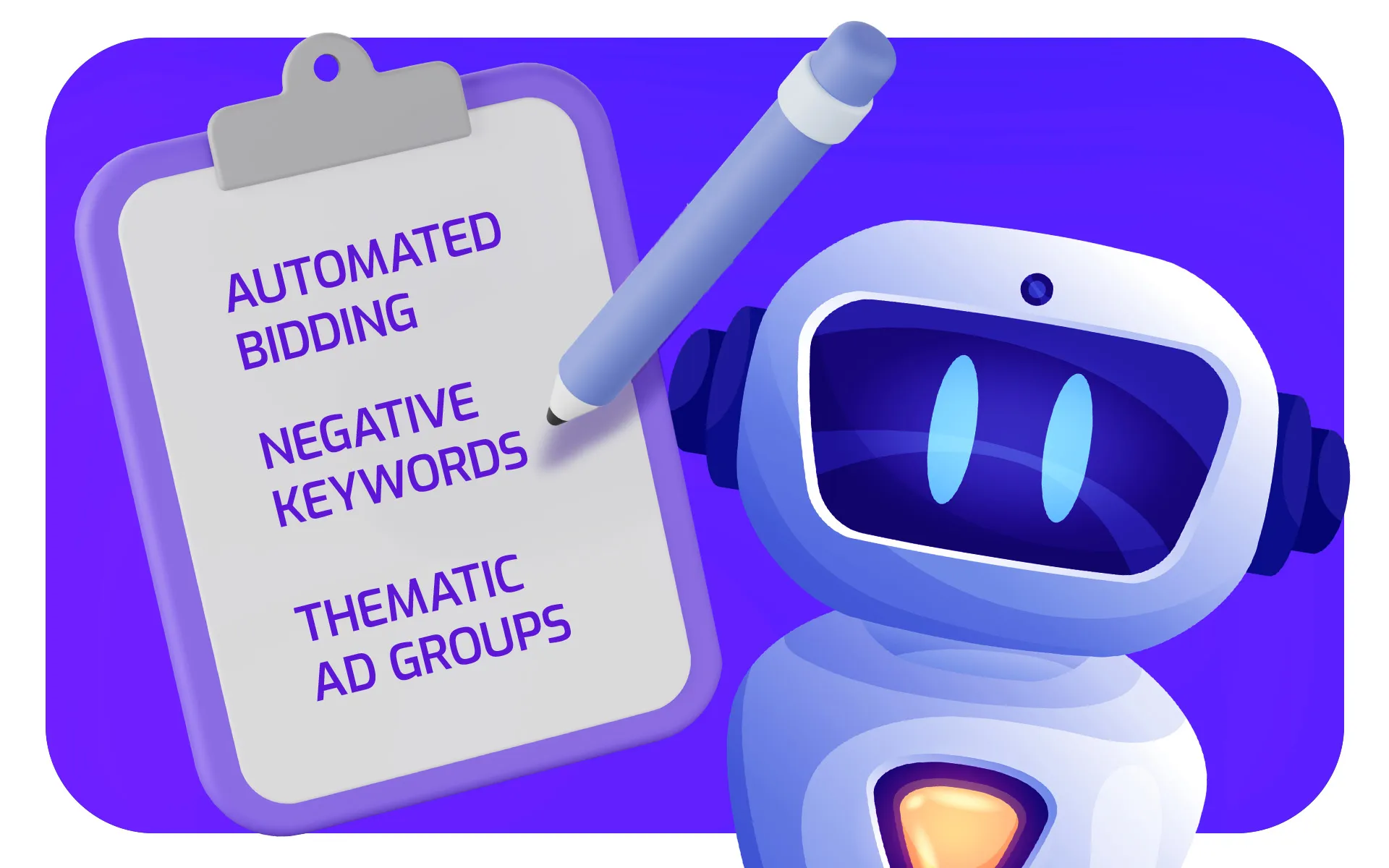read
Finding the right audience in your Google Ads campaign is like juggling a million keyword variations. Thanks to AI, broad match has gone from being a risky, “shotgun” approach to a powerful way to get great results. From 2019 to 2024, the data shows broad match is closing the gap with exact match and phrase match, especially for advertisers who use negative keywords, Smart Bidding and are monitoring closely. But with great reach comes great responsibility—you could be attracting irrelevant keywords or low-intent searches if you don’t actively manage what Google sees as a user’s search query.
A quick data-driven look at keyword match types performance from 2019–2024
How AI-powered Smart Bidding and negative keyword strategies help you use broad match better
The pros and cons of broad match, including best practices
Actionable steps to avoid wasting money on non-converting traffic
You’ll see how to use broad match with the right tools, match keyword settings and negative lists to scale your reach without burning through your ad budget.
Google Ads Campaign Performance Trends (2019–2024)
Here’s how broad match has evolved over the years, why Smart Bidding and AI matters, and what happens now that broad match is the default match type:
Year over year improvements made broad match more viable especially after 2021.
Still keep an eye on search term reports to avoid misaligned traffic.
More data from broad match queries can lead to better optimization if you keep irrelevant searches in check.
Smart Bidding plus broad match keywords is a dynamic duo; AI can refine bids quickly.
Tracking results helps you refine which queries convert.
The system can auto adjust bids to discourage low intent matches, but negative keywords are still important.
Metrics Evolution
Year | Average CTR | Average CPC | Average CVR | Average CVR | Notable |
|---|---|---|---|---|---|
2019 | Lowest among match types in many tests | 40% higher than average in some studies | Not consistently measured | Not consistently measured | About 23% of spend allocated to broad match. Mixed data on CPC; some saw lower costs, others higher. |
2021 | Generally lower than phrase match | Slight decrease vs. 2019 for many advertisers | Sometimes higher than phrase, sometimes on par | Often decreased when paired with Smart Bidding | Broad match modifiers phased out, integrated into phrase match keyword definitions. |
2023 | Narrowed gap vs. exact match | Similar to exact in some industries | Typically lower than exact but improving | Lower than exact in certain scenarios | Studies (e.g., Optmyzr) show higher efficiency when combined with negative keyword match types + AI. |
2024 | Potentially lower CTR if low intent | Varies, sometimes better with negative lists | Inconsistent; reliant on negative keywords | Default status can raise CPA if unmanaged | Automatically set to broad match for new Search campaigns, raising stakes for negative keyword usage. |
Key Takeaways
Modified broad match was retired by 2021, its functionality folded into phrase match.
After 2023 many saw broad match works well if you pair it with negative lists and smart bidding.
As of 2024 broad match is the default, so watch out for irrelevant keywords and manage through negative lists.
Smart Bidding and AI
Smart Bidding uses additional signals—like time of day, device or location—to decide how much to bid on a user’s search in real time. When you pair that with broad match coverage Google’s algorithm can interpret the same meaning or same intent behind synonyms or close variations of your keyword phrase.
Faster Conversion Optimization: Broad match gathers all the queries that circle your topic so the machine learning algorithm sees more data and can optimize faster.
Enhanced Relevance: The AI decides when to show your ad, weeding out certain irrelevant terms if it detects low conversion likelihood—but it’s not perfect.
Cost Control: With a lot of impressions it’s essential to rely on automation to control costs especially if you’re using broad match on high traffic keywords like “tennis shoes” or “keyword” categories with broad reach.
Pull Quote:
““Smart bidding works best when broad match provides a diverse set of relevant searches, feeding the algorithm with real-time conversion data.”
Default Match Type in 2024 & Beyond
In 2024 Google Ads decided to make broad match the default keyword match type for any new Google Ads campaign. Their reasoning is that broad match quickly surfaces related searches and you can then prune the unwanted ones with negative keywords.
Upside: You can discover new angles, like how someone searching “best shoes for plantar fasciitis” might match your “running shoes” broad term because the system sees a connection.
Downside: If your ad group has multiple products or services in one ad, your ad will trigger for vaguely relevant or totally off-target words.
The AI-Driven Shift in Keyword Matching
Learn how broad match went from “random traffic” to Google’s new default:
Broad match’s reputation for random triggers is less true today but not entirely gone.
AI-based matching factors in synonyms, user history and landing page relevance.
Advertisers still need to tackle irrelevant or incomplete matches with negative lists.
Google’s automation scales your ad reach but needs human oversight to prevent waste.
Past Skepticism vs. Current Reality
Broad match used to be the “spray and pray” approach, capturing everyone from your intended audience to random hobbyists. Many advertisers stuck to exact match keywords or phrase match keyword terms to keep tighter control.
Now AI improvements (like analyzing a user’s search query intent beyond exact words) have made it more feasible to use broad match. “Add broad match modifiers” was the slogan for partial control, but those are now integrated into phrase match. As a result your ability to discover new high intent queries has grown as long as you’re regularly reviewing your campaign’s performance.
Google’s Focus and Default Setting
Why does Google push broad match so hard, even making it the default? The short answer is automation. By letting AI handle the “fuzzy” matching you can potentially focus on campaign level strategy rather than micro-managing every keyword variation. Google figures the AI will identify and self correct extraneous matches.
But that only happens with your oversight.
The system can’t read your mind about brand nuances or product specifics. For example if your keyword is “shoes” you may end up paying for “tennis lessons”. You’ll need negative lists to guide the AI away from irrelevant terms.
Benefits of Broad Match
See how broad match can expand your reach, unlock new keywords and drive synergy with Smart Bidding:
Broad match is a great discovery tool for large or growth campaigns.
Each new keyword phrase can become its own exact or phrase match if it’s a winner.
AI loves big data sets—broad match plus Smart Bidding gives you plenty of user signals.
Expanded Reach & Visibility vs Exact Match
Unlike exact and phrase match, broad match can match your ad to synonyms, alternate phrasings or more specific form queries that have the same intent as your main keyword. For example a broad match type “tennis shoes” might show for “best running sneakers for tennis”, “lightweight tennis footwear”, or even “gym shoes with arch support”.
More Impressions: Since it covers more ground you can capture top of funnel traffic or brand new audiences.
Potential Lower CPC: Some 2023 data sets show broad match can have lower average CPC if you have a solid negative keyword routine.
Keyword Discovery & New Opportunities
A big benefit of broad match is that it helps you find other keywords you never thought to bid on. By looking at your “search term” data you can find creative or niche user phrases that convert. From there you might add them as exact terms or keep them under broad if your system is working well.
Definition: Negative keywords are words or phrases you exclude to prevent your ads from showing for irrelevant searches (like “free tennis tournaments” if you only sell footwear).
Refining Future Campaigns: Suppose you see a lot of queries about “arch support trainers for tennis”. That might inspire you to create a special ad group or landing page.
SEO Benefits: Even outside of paid ads, these discovered keywords can inform your content strategy.
Smart Bidding
When you combine broad match with keyword targeting and AI bidding you feed the system a giant dataset from all those queries. Over time you get refined audience intelligence about which queries convert. Not only does this approach get more conversions but it often lowers your effective CPA because smart bidding redistributes your budget to queries that have historically performed well.
Advertisers who tested broad match from 2019 to 2024 typically reported the biggest improvements in cost-efficiency once they combined negative lists with automated bidding.
Broad match used to be notorious for capturing irrelevant or “junk” leads but data suggests those leads can be filtered out if you regularly update your negative lists, fine tune your ad group structure and let the AI figure out where to bid higher or lower.
Action Steps
Segment Your Broad Match: Instead of dumping all broad keywords into one big set, create smaller groups to keep each theme consistent.
Use Negative Keywords: Immediately exclude irrelevant categories or synonyms that have nothing to do with your business.
Run Search Term Reports: Weekly or biweekly, check the queries your ads triggered. Add negative entries or spin off new exact match or phrase terms if you see high converting patterns.
Use Smart Bidding: If you’re not using automated bidding consider at least a test. AI based bidding often “learns” faster with broad data.
Disadvantages and Risks
Watch out for wasted clicks and higher spend. Broad match can blow up your budget or bring in off target leads if you don’t prune relentlessly:
Repeated irrelevant queries can drain your budget.
Expect increased management overhead as you refine negative lists and check CPC spikes.
Irrelevant Traffic & Waste
No matter how advanced Google’s AI gets, broad match still picks up queries that only partially fit your offer. Words or phrases that share some remote similarity might slip through especially if you haven’t built a thorough negative list. This risk is higher when broad match is the default match type—new advertisers might turn it on unknowingly and get clicks from random user’s search patterns.
Higher Costs & Management Demands
Running broad match effectively means you’re in your google ads interface more often. Because it covers the widest range of close variants, synonyms and other variants you’ll see surges in impressions and clicks—some profitable, some not.
Best Practices for Broad Match
To maximize broad match results combine it with automated bidding, negative lists and thematic ad groups:
Let the campaign run long enough for AI to gather more data and optimize.
A comprehensive negative keyword approach filters out wasted clicks.
Group broad match keywords into cohesive themes helps the system learn faster.

Pair with Automated Bidding Strategies
It’s no secret that smart bidding works best with robust data. Broad match gives you a big dataset and automated bidding can adjust your CPC up or down to get you the best return. Here’s a quick guide:
Set a Goal: If you’re targeting a specific cost per acquisition use Target CPA if you want a certain return on ad spend use Target ROAS.
Enable Broad Match: Test but keep a negative keyword list to corral obviously irrelevant matches.
Collect Enough Conversions: Don’t judge too soon. AI often needs a learning period especially if it’s dealing with brand new broad terms. If the campaign is too short or the budget is too small, you simply won’t collect enough usable data.
Robust Negative Keyword Strategy
Negative keywords are your guardrails against the chaos of broad match. They come in different forms: negative broad, negative phrase, negative exact. Each negative keyword match type helps refine your traffic.
Keywords Tab: The “keywords tab” in your Google Ads dashboard is your friend. Look at the triggered terms, add brand names or topics that don’t match your offer to negatives.
Periodic Audits: Every month or quarter do a deeper review of the entire negative list. Are there outdated or missing phrases?
Thematic Campaign & Ad Group Structure
When you put all your broad terms in one ad group you risk confusing the AI. If you sell tennis shoes, formal shoes and slippers all in the same group the system might show your ad to users interested in completely different footwear.
One Product per Campaign: If you can split your campaigns by major product line so the AI can focus on relevant search patterns.
Ad Group Structure: Use multiple broad keywords but keep them thematically cohesive. Each group can align with one core product or service.
Controlled Experiments & Budgets with Other Keyword Match Types
One of the safest ways to use broad match is to run it in parallel with your existing exact match and phrase match campaigns. You can set up an experiment to measure performance differences directly.
Compare CPA & ROAS: Look at the broad group vs your other match types.
Evaluate Conversions: If broad match delivers incremental conversions at a reasonable cost keep it. If it cannibalizes your best exact terms or phrase terms refine your approach.
Scale Carefully: Start with a small budget. If the data looks good increase investment.
Common Mistakes to Avoid
Don’t do these:
Neglect search term audits and you’ll be blind to irrelevant traffic.
Go all in on broad match and you’ll drop lead quality if you ignore phrase or exact.
Weak or missing conversion tracking will undermine AI bidding.
Never use Broad Match in Brand(ed) campaigns because the campaign will pick up any other terms, including competitors, general search terms etc.
Neglecting Search Term Reports
If you don’t review your search terms you have no idea how broad match is interpreting your keyword. This is the number one reason advertisers waste money on random clicks.
Pull Quote:
““Not checking your search queries is like leaving your front door open and hoping no uninvited guests show up.”
Overreliance on Broad Match
Going all in on broad match might be tempting if you see some early wins but you’ll risk losing high value queries that convert better under exact keyword targeting. Some industries or products require high precision.
Ignoring Goals & Conversion Tracking
Broad match needs meaningful accurate conversion data. How much data? Aim for 50-100 conversions per month per campaign for the ideal environment for broad match data collection. If your tracking is fuzzy—maybe you haven’t properly coded your form submissions or calls—you’ll feed the AI mixed signals. That can lead to random or wasted spending since it can’t tell good clicks from bad.
Claim Your Free Audit to Uncover Hidden Opportunities
FAQ
Conclusion
Broad match has come a long way from 2019 to 2024 from a gamble to a powerful tactic in your Google Ads campaign—provided you manage it right. By pairing broad match with smart bidding, building a robust negative keyword strategy and monitoring your keywords tab for relevant searches you can tap into new audiences without wasting money on off target clicks.
By following these steps you’ll be able to use the keyword flexibility of broad match while minimizing the risks. In 2025 and beyond using broad match effectively means being agile, trusting the AI to do its part and making sure you do yours—refining your strategy every step of the way. With ongoing tweaks you can maximize results, manage costs and turn broad match into a high performing partner in your Google Ads arsenal.


![AI Advertising in 2025: Real ROI vs Expensive Hype [Guide]](/_ipx/f_webp/img/blog/blog-ai-in-the-advertising-space.jpg)
